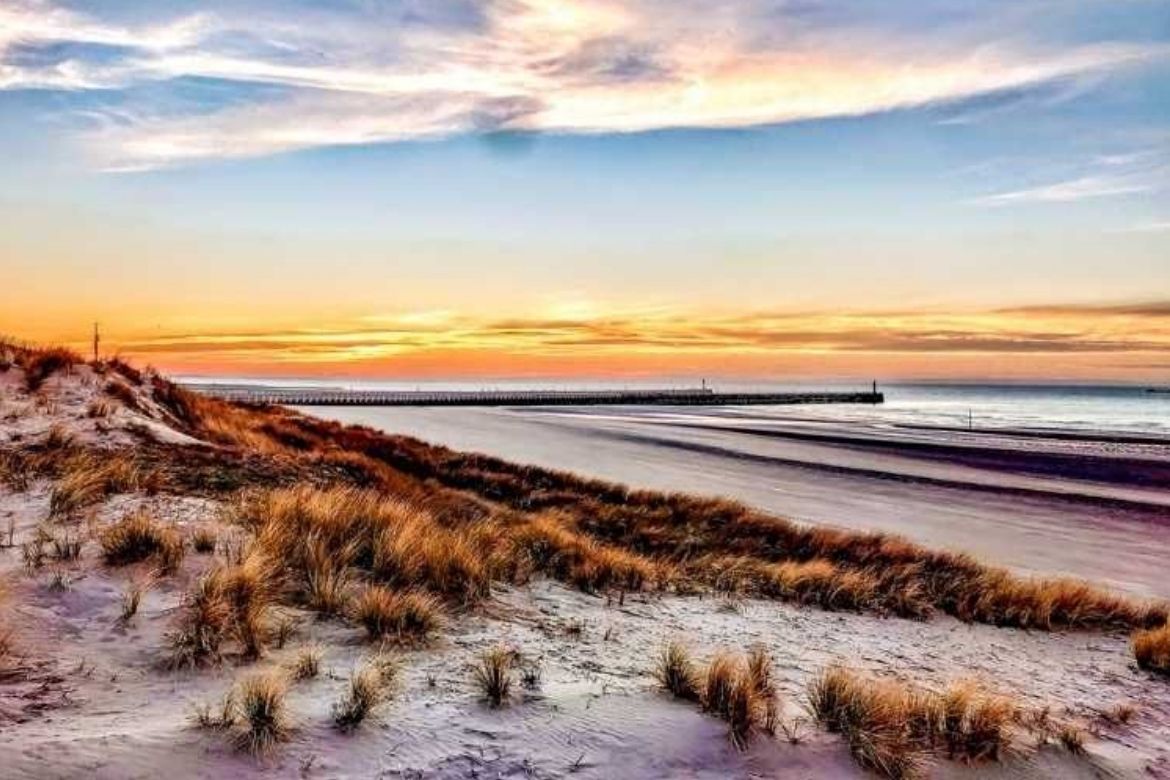While jet setters flying into the glamorous beaches of the French Riviera inevitably leave a deep carbon footprint, I decide to try a surprising slow alternative on a much lower carbon journey discovering the less glitzy but absolutely spectacular Belgian Riviera.
This proud kingdom boasts a splendid 62km North Sea shoreline of never-ending beaches and wild sand dunes that runs between the Dutch and French borders. Plus, the dozen quaint, quirky resorts along the coast are linked by an eco-friendly electric tram that has been slowly chugging up and down the world’s longest tram line since 1885. So there’s no need for a car, just hop on and off the tram.
Arriving in Brussels, I jump on the train to Ostend, arriving at a grand Belle Epoque station by the waterfront. In a city known as the “Queen of Belgium’s Seaside”, it seems only natural to check in at the chic Leopold Hotel, housed in a sumptuous Art Deco mansion, and named after the Belgian king who was behind much of the luxury development of the riviera.
Ostend has been transformed into the coast’s dynamic cultural capital, an open-air gallery where buildings are decorated with dramatic wall murals, part of an innovative programme called the Crystal Ship that regularly invites international artists to create frescoes. A serious art-lover’s tour begins at the interactive museum in the grand house of renowned local painter, James Ensor. The tour offers a fascinating insight into the influence of Ensor’s mother’s spooky curiosity shop, which housed weird and wonderful masks that inspired his signature unsettling artworks.
Afterwards, a short walk across town takes me to Mu.Zee, a former 1970s department store transformed into a cutting-edge museum showcasing contemporary Belgian art, including important works by the likes of Rene Magritte, Rik Wouters and of course, Ensor.
Next stop is De Grote Post, once the central post office, it has been transformed into a buzzing venue for film screenings, exhibitions and concerts, plus a diner and summer rooftop bar where hip locals gather for sunset cocktails.
Still an active fishing port, fresh food is always on the menu in Ostend and I cannot resist a walk along the long sandy beach to the majestic royal Venetian Galleries. Before long, I arrive at the Thermae Palace Hotel, where the lustrous Brasserie Albert transports diners back to the glittering 1930s, with impeccable uniformed waiters serving delicious plates of grilled soles and crispy shrimp croquettes.
Next morning it is time for some sun and sand as the ever-reliable coastal tram drops me off right by the French border at the lively resort of De Panne, which resembles a Victorian seaside postcard with brightly striped wind breakers and retro bathing huts, plus families building sand castles, avidly hunting for crabs, paddling and swimming. Beyond the family beach, there is the Sportstrand (sports beach), perfect for those looking for an active holiday, with everything from football and volleyball, to wind and kite surfing. I certainly cannot resist stopping at the Royal Sand Yacht Club for a beginner’s lesson in a high-velocity sand yacht that whizzes along the shoreline at what feel like terrifying speeds.
I time my visit to Oostduinkerke for one of the regular low-tide outings of the last North Sea fisherman practicing the ancient craft of shrimping on horseback. Recognised on Unesco’s intangible cultural heritage list, this is an exceptional example of sustainable tourism supporting the local community. The municipality financially support the world’s last remaining 17 fishermen and women, together with their 14 horses, who attract crowds of curious tourists when kitted out in yellow oilskins. The shrimpers mount tall dray horses, trot into the waves and drag the sand to claim highly prized wriggling grey shrimps.
As the tram trundles back to Ostend, each resort contrasts the 1970s construction boom of anonymous concrete apartment blocks with a series of monumental installations that form the avant-garde Beaufort Park of Sculptures, with 40 eye-catching artworks placed on the coast’s beaches, dunes and even in the water. Just by Westende’s De Kwinke Surfclub, The Navigator Monument is placed at the edge of the dunes, a colossal ship’s wheel half-buried in the sand. Further up the boardwalk sits Wim Delvoye’s massive rusted metal monster, Caterpillar and Flatbed Trailer, a must for all Instagrammers.
The next day, the tram heads in the other direction towards the Netherlands, with most passengers piling off at the picturesque De Haan retreat. There is no modern development here – the result of another royal decree – and this utterly charming dolls-house village has been unchanged for more than a century; expect half-timbered Anglo-Normand villas, thatched cottages, quaint bed and breakfasts, as well as grand old-fashioned hotels.
Pleasures are simple, from a hike through the dunes and renting a retro pedal cart to a round on the kitsch mini-golf course, beloved by locals and tourists alike – there is also an 18-hole golf course just outside town.
Adjoining Blankenberge presents a much more lively destination, with pleasure arcades for children, Ibiza-style beach bars and an Art Deco pier. And then, almost without realising it, I arrive at the end of the line and the glitzy allure of Knokke, which locals love to dub the Belgian Saint-Tropez. Honestly, it does not quite live up to the hype despite Michelin star gourmet restaurants and haute couture boutiques of brands such as Hermes, Louis Vuitton and Dior.
So I rapidly carry on past Knokke’s luxury hotels and exclusive villas to the coast’s final surprise, Zwin Nature Park. The breathtaking wetlands and bird reserve consists of forest and dunes that run as far as the wild grassy mudflats that form the Dutch border, peacefully inhabited by Highland cattle, sheep and wild goats. It feels like the end of the world, but fortunately, the faithful coastal tram is only a short walk away to take me back to Ostend.



